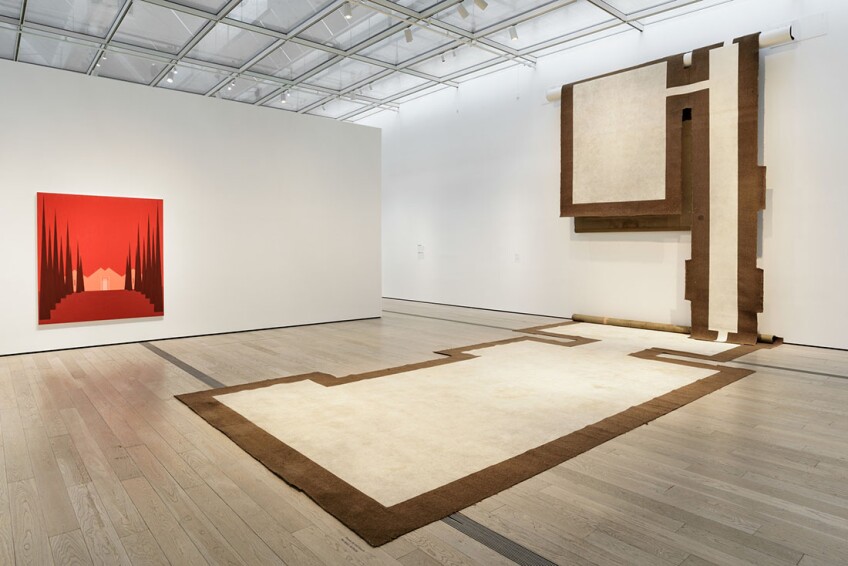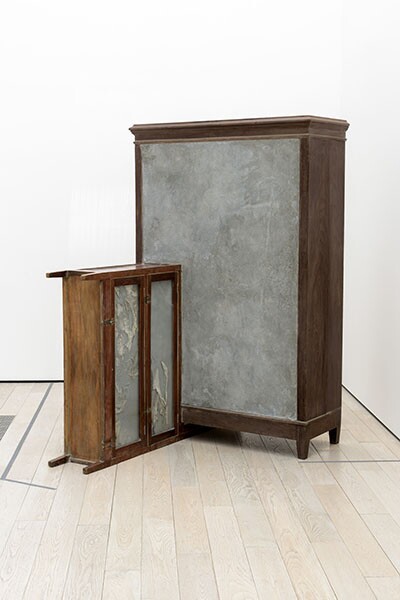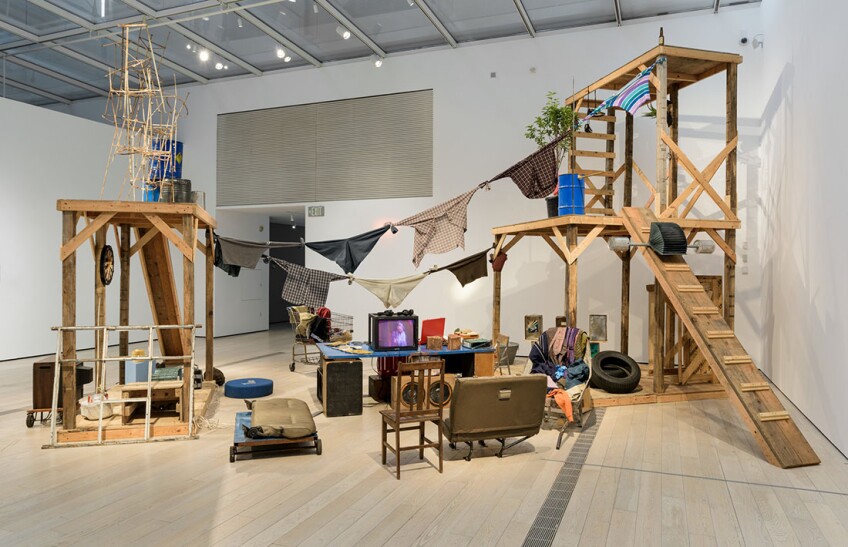Latinx Artists Explore the Idea of Home in this New LACMA Exhibit

This is produced in partnership with Pacific Standard Time: LA/LA, a far-reaching and ambitious exploration of Latin American and Latino art in dialogue with Los Angeles.

The cartoonishness of Colombian artist Johanna Calle’s “Obra Negra (Black Opus) will draw the viewer in — legs extend out from under rooftop peaks and tangled nets, roofs are half-finished, and walls haphazardly squash into each other. Its playfulness distracts one from the fact that the piece is physically crafted from sewn, razor-sharp chicken wire on cardboard, and that “Obra Negra” is a term for bare building construction, the kind that specifically manifests in slums and shantytowns.
“What’s it about?” asks a very little girl to an older friend. “What do you think it’s about?” the friend asks back. “I think it’s about how people carry their houses with them,” says the little one. On a busy Tuesday afternoon in early summer, the two young women meander away towards the moms with toddlers in strollers, day camp kids led by college students, some couples, older singles. The crowd is almost as diverse as the work on view in this far-reaching, yet sometimes overly-broad, group exhibition that is one of the first to open in this year’s Getty Foundation installment of “Pacific Standard Time Los Angeles/Latin America” (PST LA/LA) — a region-wide confluence of Latin American and local artists in exhibitions and programs that will continue into the fall.

Of the early-to-open PST LA/LA shows, “Home - So Different, So Appealing” examines the very personal idea of home and its relationship to heavy matters such as belonging, displacement and poverty, among many socio-political issues. Through paintings, sculpture, photographs, videos and installations, the exhibition offers a balance of art and architecture in reference to buildings, social structures and domesticity within systems of urban and architectural consequence.
Later this year, other shows will feature surveys on Brazilian architect Lina Bo Bardi (at the Palm Springs Museum of Art), a survey on design movements across Mexico and California (also at LACMA), an exhibit specifically looking at the border area, “The U.S. Mexico Border: Place, Imagination, and Possibility” (at the Craft and Folk Art Museum), and a critical look at modernist architecture in Latin America at the Los Angeles Municipal Art Gallery. Ancillary events will include a site-specific work by writers and Mexican artists, “Tu casa es mi casa,” at the Neutra VDL Studio and Residences in September.
But the exhibition’s broad range of viewpoints under one very familiar and fleeting theme — home — suggests a scalelessness of approaches to the ubiquitous theme, all of which come from a decidedly personal perspective.
Chon Noriega, one of three curators of “Home — So Different, so Appealing,” along with Mari Carmen Ramírez, curator and director of the International Center for the Arts of the Americas at the Museum of Fine Art Houston, and Pilar Tompkins Rivas, director of the Vincent Price Art Museum at East Los Angeles City College, says the intention was to stay away from the explicitly political or didactic, and focus on the material and the formal.
Noriega is the director of UCLA Chicano Studies Research Center and adjunct curator at LACMA.
“Many [of the artists] are investigating elements at a local, granular level in the works,” says Noriega, “because that's where these things play out, and they don't have to go to a certain level of abstraction to achieve what they want to communicate.”
_________


In one of the exhibit’s deepest galleries, at the half-way point through the show (from pretty much any path one chooses through the BCAM’s third floor galleries), is Gordon Matta-Clark’s 1974 Super 8 film “Splitting” in which he saws through a house to open it up, separating one side from the other, so he can slip in between. Its subtle placement provides the fulcrum of the exhibition in many ways, and not only because Matta-Clark’s dialogs with architecture and art are well known — the artist studied architecture at Cornell and his father worked with the Swiss godfather of modernism, Le Corbusier. His intervention into a home isn't strictly architectural, but psychological and social. The slicing of the house creates new views out-of itself to trees and sun that glitter through the walls, and establishes re-imagined sight lines to the exterior and interior.
Across the room, the Mexican-born painter Salomon Huerta’s, moody musings on the southern Californian single family suburban house teeters on the edge of fantasy and foreboding, using deep colors and primary geometries to build up a creeping but quiet tension through strange perspectives and shadows. Both Matta-Clark’s famous video piece “Splitting” and Huerta’s emerging practice of painting remove the idea of home from its accepted cultural understandings and re-position it, respectively through destruction and recasting, towards beautiful new potentials (one carved open in Matta-Clark’s case), or something more menacing a la “Pleasantville” (in Huerta’s works). They reveal fundamental structures unseen during the typical occupation of the physical or emotional idea of “home.”
“Architecture rears its head in many ways, but the pieces talk about an architecture you carry in your head as a memory,” says Noriega, and adds.
Another student of architecture who moved into art practice later in life is Rafael Montañez Ortiz. His archaeological artifacts are wild, unruly compositions from destroyed sofa beds, wire, rusted mesh and only vaguely identifiable remnants of home furnishings and building materials. His work shares a room with Doris Salcedo’s concrete-filled furniture pieces, which command a heavy stillness in contrast to Montañez Ortiz’s exuberant wall pieces.
“We wanted to find a compelling case for works in dialog across generations and media and regions,” explains Noriega, “We didn't necessarily want works to be viewed on their own terms.” he says of the strategic positioning of pieces.
The most significant of the works in dialog are three pieces that include María Teresa Hincapié’s 1990 video “Una cosa es una cosa", a performance in which the artist sets out and organizes personal possessions into a square spiral across the floor, and Abraham Cruzvillegas’ “Autoconstruccion” with Jorge Pedro Nunez’s collages on paper — the “El sueno de tuna casa” series. Cruzvillegas’ stacked tortillas, workout equipment and hung-up clothes reveal tasks half done around the house and the humdrum operations of quotidian life laid out on the gallery floor, though not as formally intentional as María Teresa Hincapié’s. The informalities of domesticity play against Nunez’s collages, which combine glossy home interiors advertisements sliced up to reveal photographs of exposed cracking brick facades on layers behind.

As for the heavy focus on domesticity and its intersections into feminism, psychology and politics, says Noriega, “Work in 1950 marked a shift in art – there was new acceptance for collage, found art, photography.” Using the materials of home, many artists began a critique of dominant domestic consumption, which, Noriega adds, goes hand in hand with economic development patterns and urbanism.
“The title of the exhibition comes from a home magazine of that era,” says Noriega. “That advertising language is used as a basis for introducing consumer goods, and within that are many questions about the American dream and its implications, and implications of its export to other places.” (The title also refers to the artist Richard Hamilton’s prophetic pop art piece of the same era, “Just What Is It That Makes Today’s Homes So Different, So Appealing?”)
Ramiro Gomez’s ten small domestic scenes include painted figures of Latino home workers, cleaning ladies and nannies mostly with their backs turned away from the viewer, are placed both perfectly and awkwardly within home style magazine advertisements. By re-inserting the Latino worker into the composed shots, the invisible immigrant worker is simultaneously made visible while her disconnection to the manicured world around her is even more pronounced. Gomez’s paintings can be found just outside a room streaming Theresa Serrano’s video piece that’s an assemblage of suspenseful shots amidst a noir-ish dream, with an air of drama as if something big is about to happen.
Christina Fernandez’s series of photographs depicts a radical revisionist dramatization of her own grandmother’s life, and Livia Corona Benjamin’s video piece “El Pan“ finds signs of real life — a foosball table on sidewalk, couples walking arm in arm — on a bread truck as it roams among standardized housing blocks that stretch on relentlessly across acres.
Julio Cesar Morales’ “Boy in a Suitcase” rounds out the circuit, and is one of the most recent works in view (from 2015). The digital piece is an actual archive of a single x-ray image taken by Spanish custom officials when they discovered an eight-year-old boy hiding in a suitcase, coming from the Ivory Coast to Spain via Morocco to reunite with his father. The animation video re-creates visuals from the boy’s perspective of what he might have seen through a small zipper in the suitcase. The animation contains in its process as well as its presentation the simultaneous representation of memory, informality, persecution, boredom, capitalism — all become intertwined where we live or don’t live at the most personal and intimate scale.

Top Image: Salomon Huerta, Untitled House, 2003, Collection of Sam Schwartz. © Salomon Huerta, photo courtesy of Christopher Grimes Gallery

![[Left] "Santa Barbara Brown Berets aka Moratorium in Maravilla" 1970. | Photo: Oscar Castillo || [Right] "Not One More (Girl with Beret)" 2016. | Photo: Rafael Cardenas](https://kcet.brightspotcdn.com/dims4/default/13393e7/2147483647/strip/true/crop/723x723+283+0/resize/200x200!/quality/90/?url=http%3A%2F%2Fkcet-brightspot.s3.us-east-1.amazonaws.com%2Flegacy%2Fsites%2Fkl%2Ffiles%2Fthumbnails%2Fimage%2Ffeatured_oscar_castillo_and_rafael_cardenas_photos_brown_be.jpg)
